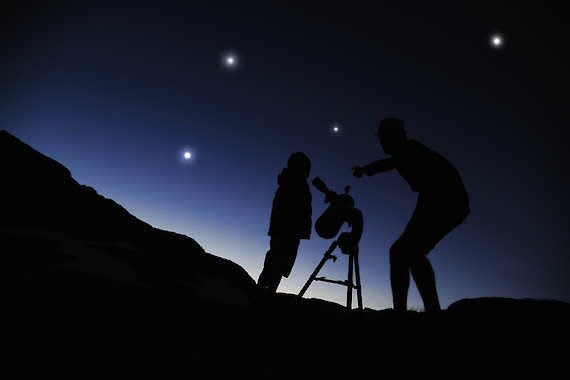Star Trak: Venus, Jupiter are will 'almost meet' in February night skies

Three bright planets will be visible every evening in February.
Venus and Jupiter will shine brilliantly in the southwestern sky nearly 30 degrees apart on Feb. 1. Each evening Venus will climb higher and Jupiter will drop until they almost meet on Feb. 28. Venus will be the brighter of the two, appearing 10 degrees high an hour after sunset at the start of the month and setting two hours after the sun. By the last evening of the month Venus and Jupiter will be about 1 degree apart low in the west. An hour after sunset they will be 20 degrees high and remain visible until at least 8 p.m. local time. Jupiter will be a fine target for telescopes of any size.
Mars will shine brightly in the constellation Taurus, outshining the orange star Aldebaran 8 degrees to its south on Feb. 1. The Red Planet will start the month 10 degrees east of the Pleiades star cluster and gradually move eastward.
Mercury will appear low in the southeast before dawn. On Feb. 1 it will be 4 degrees high an hour before sunrise. By mid-month it will be disappearing into the morning glow.
My Favorite Ride:10 years of restoration and retired mail carrier has '66 Chevy like one he regrets selling
Saturn will be visible low in the west for less than an hour after sunset in early February. It will pass through conjunction with the sun and reappear in the morning sky in March.
Zodiacal light easier to see on winter nights
If you live in an area that is dark enough for you to see the Milky Way sprawling across the night sky, you also have a chance of seeing the interplanetary dust in the plane of our solar system. Moonless evenings in late winter and early spring are the best time to see this dust. As darkness falls, look for a faint pyramid of light spreading upward from the western horizon over a large area of the sky. This is the zodiacal light, which is sunlight reflected from trillions of dust particles left behind in space by comets and asteroids that orbit the sun in the same plane as the planets.
Moon phases
The moon will be full on Feb. 5, at third quarter on Feb. 13, new on Feb 20, and at first quarter on Feb. 27.

Hal Kibbey is a retired science writer for Indiana University and is an amateur astronomer. Email him at hkibbey@gmail.com.
This article originally appeared on The Herald-Times: Venus, Jupiter are will 'almost meet' in February night skies
